Boric acid destroys termites effectively because it attacks their bodies on multiple fronts simultaneously. When termites contact or ingest boric acid, it disrupts their digestive enzymes, preventing them from processing food and leading to starvation. The compound also acts as a powerful desiccant, drawing moisture from their exoskeletons and causing fatal dehydration. Most importantly, affected termites carry the toxin back to their colonies, spreading it through grooming and feeding behaviors to eliminate entire populations including queens and workers.
What Makes Boric Acid a Powerful Termite Killer
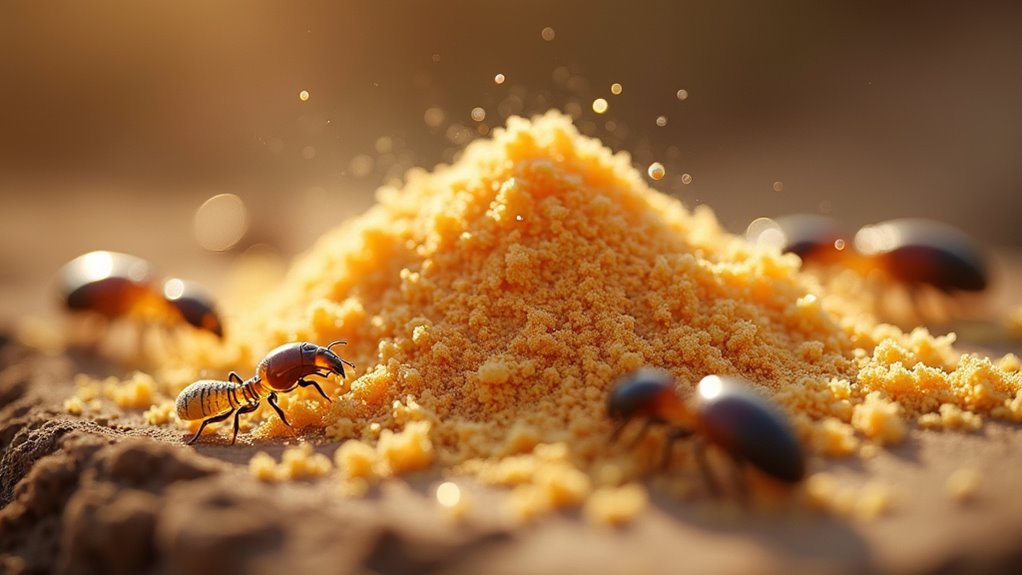
When termites encounter boric acid, they’re facing a lethal threat that attacks their most essential biological functions. This natural compound disrupts both their digestive and nervous systems simultaneously, creating a devastating double assault.
Boric acid delivers a lethal double assault on termites, simultaneously disrupting their digestive and nervous systems with devastating effectiveness.
As boric acid absorbs through their exoskeletons or gets ingested, it triggers dehydration that slowly weakens termites from within.
What makes this such an effective solution for termite control is its delayed action. Rather than killing termites instantly, boric acid allows them to return to their colony and unknowingly spread the toxin to other members.
This creates a cascading effect that helps eliminate termites throughout the entire population. The slow-acting poison guarantees maximum colony penetration, making boric acid a powerful weapon against these destructive pests.
How Boric Acid Disrupts Termite Digestive Systems
As termites consume boric acid, the compound immediately begins attacking their digestive enzymes, preventing proper food breakdown and nutrient absorption.
This disrupts their digestive system so severely that termites can’t process food effectively, leading to starvation even when food sources remain available.
Boric acid doesn’t just kill termites through starvation—it creates a devastating chain reaction throughout the colony:
- Enzyme destruction – The acid destroys critical digestive enzymes, making food processing impossible
- Dehydration acceleration – Water loss through the exoskeleton intensifies as the compound circulates
- Colony contamination – Infected termites spread the acid through grooming and feeding behaviors
This spreading effect makes boric acid particularly lethal against worker termites who feed the entire termite colony, eventually reaching and eliminating the queen herself.
The Science Behind Boric Acid’s Dehydrating Effects
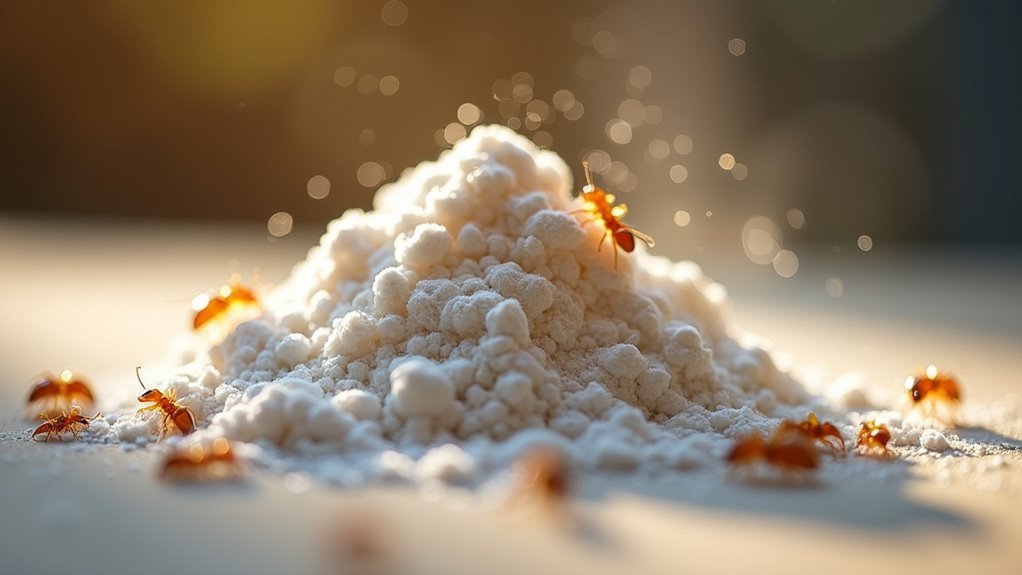
Beyond digestive disruption, boric acid launches a secondary attack that proves equally devastating to termites.
Boric acid works as a powerful desiccant, systematically drawing moisture from the termite’s body through its permeable exoskeleton. This chemical penetration triggers rapid cellular dehydration, causing crucial organs to malfunction as water levels plummet. The dehydrating effects become increasingly severe over several days, weakening the termite’s ability to survive.
What makes this mechanism particularly lethal is how affected termites carry the substance back to termite colonies, spreading contamination throughout the nest. This delayed-action approach creates an effective pest control solution that targets not just individual foragers, but entire populations including queens and workers, maximizing colony-wide elimination.
Colony-Wide Impact Through Termite Social Behavior
The highly social nature of termite colonies transforms boric acid from an individual threat into a colony-destroying force. When worker termites ingest boric acid while foraging, they don’t just harm themselves—they become carriers that spread the toxic substance throughout their entire community.
Through shared feeding behaviors, contaminated workers distribute the poison to other colony members, including the vital queen.
This social behavior creates a devastating chain reaction:
- Food sharing networks – Workers distribute contaminated food to nestmates during feeding exchanges
- Grooming rituals – Termites transfer boric acid particles while cleaning each other’s bodies
- Colony-wide decline – Disrupted workers can’t maintain essential care responsibilities, destabilizing the entire social structure
The interconnected nature of termite colonies means a few affected individuals can trigger complete colony collapse, making boric acid remarkably effective.
Safety Advantages Over Chemical Pesticides
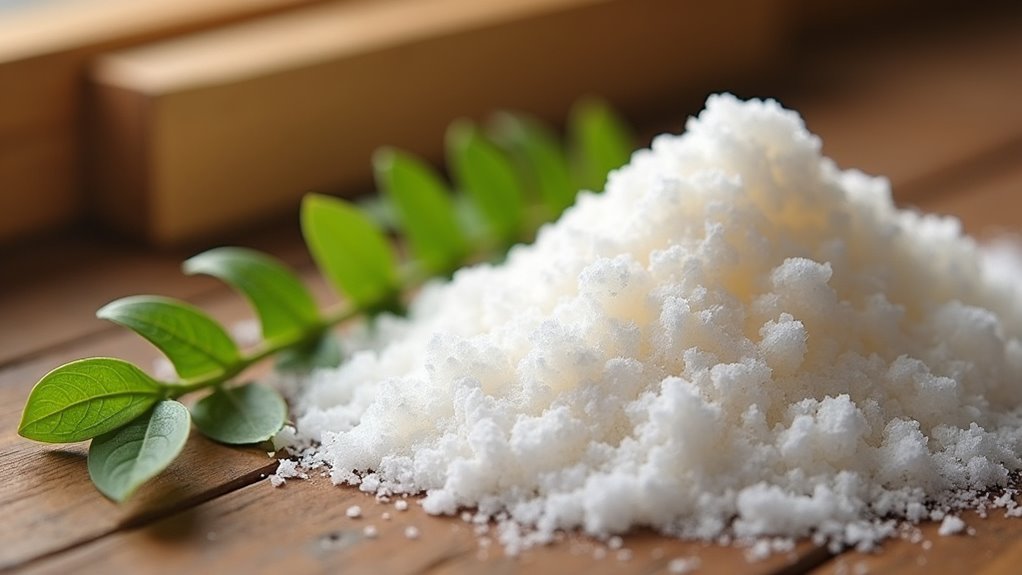
When you’re choosing between boric acid and chemical pesticides for termite control, you’ll discover that boric acid offers significant safety advantages that make it an ideal choice for protecting your family and environment.
This naturally occurring compound demonstrates low toxicity to humans and pets, establishing itself as a safer alternative to synthetic pesticides containing harmful ingredients.
You won’t need to vacate your home during treatment since boric acid doesn’t leave dangerous residues requiring extensive cleanup.
Its non-toxic approach targets termites through digestive disruption rather than neurotoxic effects found in conventional insecticides.
You’re also protecting beneficial insects and ecosystems through targeted application that reduces environmental pollution and minimizes widespread chemical contamination.
Best Methods for Applying Boric Acid Against Termites
You’ll find that applying boric acid against termites requires strategic methods to maximize its effectiveness.
The three most proven approaches include creating concentrated wood treatment solutions, setting up termite bait stations with cellulose attractants, and using targeted spray applications for direct contact with termite activity.
Each method serves a specific purpose in your termite control strategy, from preventing infestations to eliminating active colonies.
Wood Treatment Solutions
Three primary methods exist for applying boric acid wood treatments against termites, each offering distinct advantages depending on your specific situation.
You’ll want to create a concentrated solution using 1.5 pounds of boric acid dissolved in one gallon of water for maximum effectiveness against termite infestation.
Your DIY pest control approach should focus on these application techniques:
- Brush application – Paint the solution directly onto wooden structures using a standard paintbrush for precise coverage.
- Spray treatment – Use a spray bottle to cover larger areas and hard-to-reach spaces efficiently.
- Saturation method – Thoroughly soak damaged wood to guarantee deep penetration into the grain.
Target areas showing mud tubes or visible damage first, as this increases your chances of reaching the colony and achieving effective termite elimination.
Termite Bait Stations
While direct wood treatment works well for visible termite damage, bait stations offer a more strategic approach that targets entire colonies at their source.
You’ll place these stations around your property’s perimeter, particularly near signs of termite activity like mud tubes or droppings. The cellulose-based termite bait contains boric acid that disrupts termites’ digestive systems, causing death while spreading the toxin throughout the colony.
Strategic placement maximizes effectiveness, but you can’t just set and forget these stations. Regular monitoring and maintenance are essential—you’ll need to replenish bait and inspect for activity.
For best results, combine bait stations with moisture control and regular inspections to create thorough pest control that addresses termites systematically rather than reactively.
Spray Application Techniques
When targeting termites with precision becomes your priority, spray applications offer the most direct method for delivering boric acid exactly where it’s needed.
You’ll create an effective boric acid solution by mixing 1 teaspoon of powder with 1 cup of water for targeted treatment of mud tubes and termite entry points.
For this DIY termite approach, consider these vital techniques:
- Direct targeting – Spray mud tubes and entry points with your basic solution for immediate impact
- Wood surface treatment – Use a concentrated mix (1.5 pounds per gallon) to coat vulnerable wood areas
- Precision application – Target specific zones to protect beneficial insects while maintaining effectiveness
Regular reapplication serves as an important preventive measure, especially after rain or high humidity.
Always apply boric acid with precision to avoid environmental impact.
Wood Treatment Techniques Using Boric Acid Solutions
When you’re treating wood with boric acid solutions, you’ll need to get the concentration right, choose the proper application tools, and understand how the drying process works.
Your success depends on mixing 1.5 pounds of boric acid per gallon of water and applying it with brushes or sprayers for even coverage.
You must also allow adequate time for the wood to absorb the solution completely before considering the treatment effective.
Concentration and Mixing Ratios
Because proper concentration determines the effectiveness of your boric acid wood treatment, you’ll need to create the right mixture for your specific termite control needs.
For concentrated termite control applications, dissolve 1.5 pounds of boric acid in one gallon of water. This potent solution provides maximum protection for heavily infested areas.
However, general maintenance requires less aggressive mixing ratios – combine 1-2 teaspoons of boric acid powder with one cup of water for a 1-2% solution.
Key concentration guidelines for ideal results:
- Use concentrated mixtures (1.5 lbs per gallon) for severe infestations and untreated wood surfaces
- Apply standard dilutions (1-2%) for routine preventive treatments and maintenance applications
- Adjust solution strength based on environmental conditions and infestation severity levels
Proper mixing ratios guarantee effective penetration without oversaturating wood surfaces.
Application Methods and Tools
Successful termite elimination depends heavily on selecting the right application methods and tools for your boric acid treatment.
You’ll need a paintbrush or spray applicator to guarantee even coverage across exposed wood surfaces. These tools help your boric acid solution penetrate deeply into the wood, providing long-term protection that’s effective against termites.
For targeted treatment, apply the solution directly to mud tubes and termite entry points to disrupt their pathways. You can also set up bait stations filled with boric acid mixed with cellulose to attract termites and reduce their population over time.
Remember that outdoor applications require regular reapplication since moisture and weather conditions will dilute the solution’s effectiveness, making consistent monitoring essential for success.
Drying and Absorption Process
After applying your boric acid solution to wood surfaces, the drying and absorption process becomes essential for achieving maximum termite protection.
You’ll need to allow the treated wood to remain undisturbed while the solution fully saturates the material. This critical phase guarantees the boric acid penetrates deep into wood fibers, creating an effective pest control solution that termites will ingest during feeding.
The absorption process requires patience and proper conditions:
- Allow 24-48 hours for complete saturation and initial drying in well-ventilated areas
- Avoid moisture exposure during the drying period to prevent dilution of the treatment
- Maintain consistent temperature between 60-80°F for ideal absorption rates
Once dried, your treated wood becomes inhospitable to termite infestations, providing long-lasting protection through this proven drying and absorption process.
Creating Effective Boric Acid Termite Baits
When dealing with termite infestations, you’ll need to craft bait stations that combine boric acid with materials termites naturally seek out.
Mix boric acid powder with cellulose materials like cardboard or paper to attract termites effectively. Use a 5-10% concentration of boric acid in your termite baits to guarantee the compound will disrupt digestive systems once consumed by foraging workers.
Place these stations strategically around your property, focusing on areas with known termite activity. You’ll maximize exposure and consumption rates this way.
Check and replenish bait stations regularly to maintain their attractiveness and accessibility.
Monitor effectiveness by inspecting for reduced termite activity, including fewer sightings, decreased damage, and diminished mud tube presence around treated areas.
Limitations When Facing Severe Termite Infestations
When you’re dealing with severe termite infestations, boric acid’s effectiveness hits significant walls that can leave your property vulnerable.
You’ll find that reaching deeply nested colonies becomes nearly impossible since the treatment requires direct contact, while the slow-acting nature means weeks of continued damage before you see results.
You’ll also need to constantly reapply the treatment, especially in outdoor areas where weather conditions quickly reduce its potency.
Colony Access Challenges
Although boric acid can effectively eliminate individual termites and small colonies, it faces significant limitations when confronting severe infestations.
Colony access challenges become particularly problematic when dealing with subterranean termites that establish extensive underground networks.
You’ll encounter these major obstacles:
- Deep soil penetration – Subterranean termites build colonies far beneath the surface where boric acid can’t reach effectively.
- Multiple colony locations – Severe infestations typically involve numerous interconnected colonies requiring thorough treatment.
- Protected queens and cores – Boric acid’s effectiveness diminishes when it can’t penetrate to the colony’s reproductive center.
When facing these colony access challenges, you’re often limited to treating visible signs rather than eliminating the source.
Professional pest control services become essential for severe infestations, as they possess specialized equipment and techniques to locate and treat hidden underground colonies.
Slow Acting Results
Boric acid’s delayed effectiveness creates a critical vulnerability during severe termite infestations. You’ll face a dangerous waiting period where colonies continue reproducing and damaging your property’s structure. This slow-acting treatment can’t keep pace with rapidly expanding termite populations.
| Timeline | Termite Activity | Damage Risk |
|---|---|---|
| Days 1-7 | Colony remains active | Ongoing destruction |
| Weeks 2-3 | Partial colony reduction | Continued feeding |
| Month 1+ | Variable effectiveness | Cumulative damage |
The extended timeframe creates false security, potentially costing you thousands in additional termite damage. When facing severe infestations, you shouldn’t rely solely on boric acid. Professional help provides immediate intervention, while regular termite inspections guarantee early detection before infestations become overwhelming.
Reapplication Requirements Increase
Beyond the waiting game, you’ll encounter mounting maintenance demands that make boric acid increasingly impractical for severe infestations.
The reapplication cycle becomes relentless when dealing with extensive termite colonies that spread across multiple areas of your property.
Weather conditions wash away outdoor treatments, forcing you to constantly retreat affected zones. Deep-nested colonies require repeated applications to penetrate all areas where termites hide and breed.
- Frequent reapplication schedules – Every few weeks for outdoor areas exposed to moisture
- Multiple treatment zones – Extensive infestations demand simultaneous treatment of numerous locations
- Ongoing monitoring requirements – Constant vigilance needed to prevent re-infestation
For intricate termite control scenarios, boric acid alone won’t deliver the thorough solution you need.
You’ll find yourself trapped in an endless cycle of reapplication without achieving complete elimination.
Combining Boric Acid With Other Natural Remedies
While boric acid works effectively on its own, you can amplify its termite-fighting power by pairing it with other natural remedies.
Orange oil creates a potent combination, delivering a 77% success rate while disrupting termite communication and feeding patterns.
Orange oil delivers impressive 77% termite elimination rates by disrupting their communication networks and natural feeding behaviors.
You can develop DIY solutions by mixing boric acid with diatomaceous earth to form natural barriers that dehydrate insects on contact.
Nematodes provide soil-level protection while boric acid handles surface treatments, ensuring termites come into contact with lethal compounds at multiple points.
Cellulose-based baits infused with boric acid offer strategic colony disruption as termites ingest the mixture during feeding.
These natural remedies work synergistically to eliminate termites more thoroughly than single-ingredient approaches.
When Professional Treatment Becomes Necessary
Although boric acid and natural remedies can handle minor termite problems, you’ll need professional intervention when visible signs indicate a major infestation.
When you spot mud tubes, discarded wings, or structural damage, it’s time to call experts who can develop a thorough treatment plan.
Professional pest control technicians possess the expertise to identify termite species and locate all entry points.
They’ll conduct a detailed termite inspection to assess the full scope of damage and create targeted solutions that reach entire colonies.
Key indicators you need professional help:
- Visible structural damage to wooden beams, floors, or walls
- Multiple mud tubes along foundation walls or interior surfaces
- Persistent signs of termite activity despite DIY treatment attempts
Don’t risk extensive damage—professionals can save you thousands in costly repairs.
Frequently Asked Questions
How Effective Is Boric Acid for Termites?
You’ll find boric acid moderately effective against drywood termites through direct contact, but it won’t eliminate entire colonies. It’s less effective against subterranean species and requires regular reapplication for lasting results.
What Kills Termites the Fastest?
Professional liquid insecticides kill termites fastest, often within hours of contact or ingestion. You’ll see rapid results compared to slower options like boric acid, which takes days or weeks to eliminate colonies completely.
What Is the Most Effective Chemical for Termite Control?
You’ll find fipronil’s the most effective chemical for termite control. It attacks their central nervous system, causing paralysis and death within days. Professional exterminators often combine it with hexaflumuron for thorough colony elimination.
How Long Does It Take Borax to Kill Termites?
You’ll see borax take several days to weeks killing termites, depending on infestation size. It gradually disrupts their digestive systems and causes dehydration. Smaller colonies die faster than larger ones.
In Summary
You’ve learned why boric acid works so effectively against termites through its dual action of disrupting digestion and causing dehydration. While it’s safer than chemical pesticides and can spread throughout colonies, you’ll need to create proper baits for maximum impact. Remember that severe infestations require professional intervention, but combining boric acid with other natural methods can enhance your termite control efforts considerably.

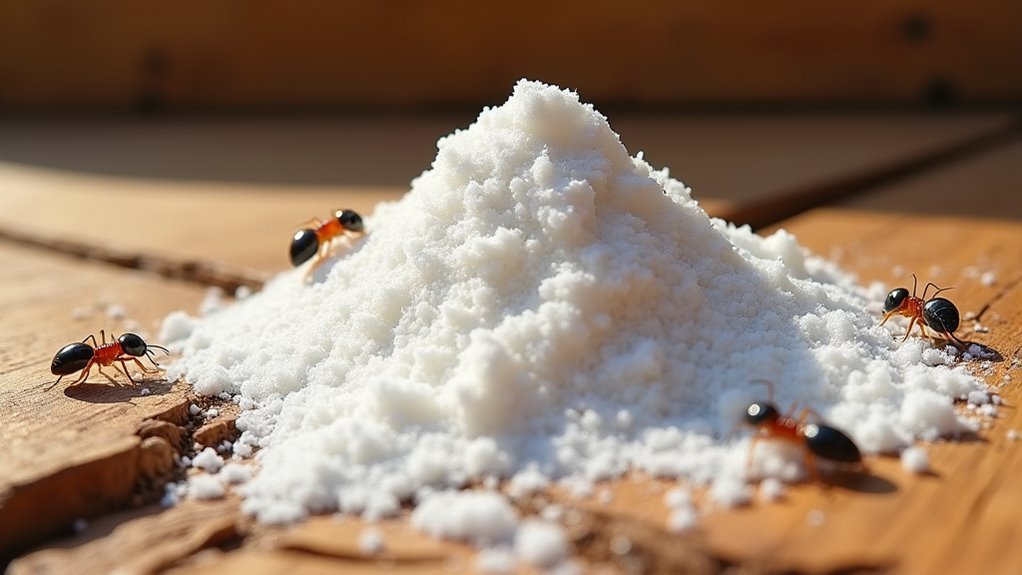
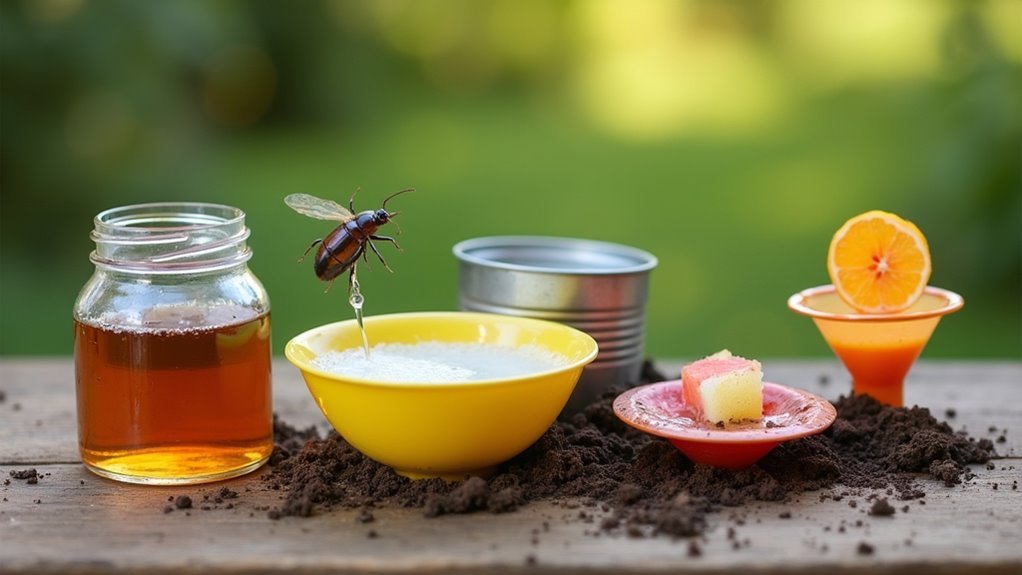


Leave a Reply